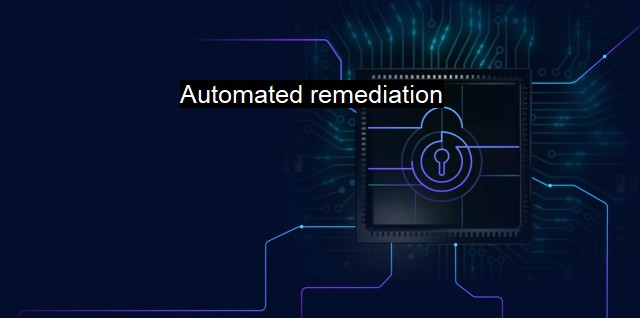What is Automated remediation?
Automated Remediation: An Advanced Approach to Cybersecurity Incident Response and Mitigation in Organizations
Automated remediation is an advanced and intelligent mechanism that automatically detects, assesses, and resolves security vulnerabilities, threats, and other abnormalities. It involves processes, measures, and mechanisms that fix security or compliance issues without the need for human interference. automated remediation streamlines the bug fixing process, allows for real-time response, and significantly reduces the time taken to manage and solve potential threats.Implementing automated remediation begins with the detection phase. Using comprehensive algorithms and machine learning, cybersecurity systems can scrutinize networks and systems, continuously hunting for irregularities, vulnerabilities, or suspicious activities. Unusual login activities, the initiation of malicious processes, probing for vulnerabilities in the network infrastructure and breach of compliance rules are some examples of abnormalities these systems can identify.
Once red flags have been flagged, the cybersecurity system commences the assessment stage. Here, the system determines the severity of the detected irregularity. Threats are categorized by assessing their potential vulnerability, risk of exposure, and consequences it could lead to if unmitigated. The algorithms consider various factors such as the type of threat, sensitivity of data at risk, and potential aftermath of rendering the risk uncontrolled.
Post assessment, the remediation process begins. In manual remediation, an IT professional steps in at this stage to manage and mitigate the threat. But in automated remediation, a set of define rules and algorithms allow the system to decide and implement the best strategy to resolve the risk. a system might isolate infected files, close ports under attack, restrict access privileges or automatically apply patches, all in real time.
Automated remediation is also efficient in patch management, one of the primary features of cybersecurity management. Software developers often release patches to fix bugs and vulnerabilities within their product. manually searching, testing, and implementing these patches can be time-consuming. Automated remediation software not only finds and installs these patches but can also check their compatibility and potential risks before implementation.
The power of automated remediation shines in its swift corrective action. Reducing the time lapse between issue detection and remediation is crucial in a thriving and dynamic cyber threat landscape. Another valuable advantage of this approach is the reduction of human error. It removes the potential for oversight in complex remediation processes and lends consistency and accuracy inherent to rule-based systems.
It is crucial to point out that while automated remediation streamlines processes and boosts security, it does not entirely replace the human role in cybersecurity. Trained IT professionals are required to configure automated systems, monitor its workings, interpret its findings, and, fundamentally, to understand and respond to complex or unique threats beyond the understanding of rule-based metrics. decisive action such as disabling user accounts or shutting down systems often require human review and judgement, overlaying automated mechanics with human scrutiny.
In a way, automated remediation works best in conjunction with human intelligence. While automation provides scalability, speed, and precision; humans offer intuition, improvisation, and ethical consideration. With cyber threats growing increasingly sophisticated, automated remediation tools offer valuable support to cybersecurity efforts, with the capability to respond faster, work constantly, and minimize human error. This sets a comprehensive, multi-layered shields around systems, providing a critical defense line in a digitized wildfire of innovation, interconnectivity and, inevitably, vulnerability.

Automated remediation FAQs
What is automated remediation in the context of cybersecurity and antivirus?
Automated remediation refers to the process of automatically identifying and resolving security issues without requiring manual intervention. It involves using machine learning algorithms to detect and respond to threats in real-time, thereby reducing the time and effort required to ensure systems are secure.How does automated remediation work in antivirus software?
Automated remediation works by leveraging AI and machine learning to detect and respond to threats in real-time. When a threat is detected, the software will automatically quarantine the file, delete it, or take other actions as necessary to prevent the spread of the threat. This eliminates the need for manual intervention, saving time and effort while ensuring that the system remains secure.What are the benefits of using automated remediation in cybersecurity and antivirus?
Automated remediation offers several benefits, including faster response times, reduced downtime, and increased system availability. It eliminates the need for manual intervention, which not only saves time and effort but also reduces the risk of human error. It also helps ensure that security policies are consistently applied across the organization, improving overall security posture.What are the key considerations when implementing automated remediation in cybersecurity and antivirus?
When implementing automated remediation in cybersecurity and antivirus, it is important to ensure that the software is configured correctly and that policies are properly defined. It is also important to monitor the system for false positives and to ensure that the software is not overly aggressive in its response to threats. Additionally, it is important to ensure that staff is trained to understand the limitations and capabilities of the software, and that appropriate escalation procedures are in place in case of unexpected events.| | A | | | B | | | C | | | D | | | E | | | F | | | G | | | H | | | I | | | J | | | K | | | L | | | M | |
| | N | | | O | | | P | | | Q | | | R | | | S | | | T | | | U | | | V | | | W | | | X | | | Y | | | Z | |
| | 1 | | | 2 | | | 3 | | | 4 | | | 7 | | | 8 | | |||||||